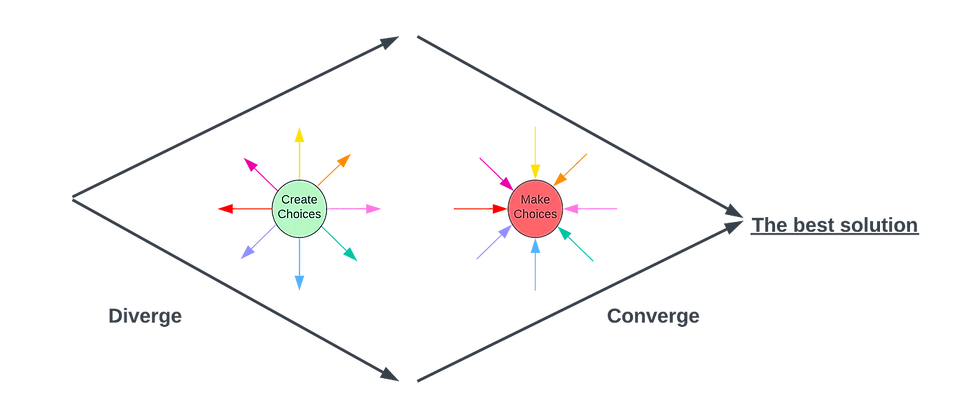Learnings from Stanford GSB: Wk2
- Dylan Pathirana

- Feb 12, 2024
- 7 min read
Design Thinking
Design thinking is a set of mindsets, methods, behaviours and practices designed to allow us to be more creative about solving problems. The process can be broken down into the core steps that are outlined below:
Stanford design thinking process
Empathy
We want to design something that people actually want and need so we must talk to our users before beginning the ideation process. That is the goal of the Empathy step. In the beginning, we think we know what our customer’s needs are, but we actually don’t. Sometimes the customers themselves may not even know what they need. By interviewing and observing your customers, you develop a much better understanding of the problems they face and the current workarounds they use to fill the gap. It is also possible to conduct immersion where you exactly replicate the scenarios that your users face. This gives you the ability to see and feel what they experience.
When conducting empathy work, it is important to dig deep into the customer’s reasoning and pain points. One key way to do this is to ask “Why”. This helps to zoom out and maximise the potential solution set. It is also valuable to consider extreme users. These are edge-case users whose specific needs may warrant a product that will actually provide benefit to the mass market. An example of this is Oxo Good grip utensils. An edge case user for them was people with arthritis who were struggling with poorly designed utensil handles. By designing to suit the edge case need, they developed an easier-to-use product that was well received by the mass market.
Oxo Good Grip Peeler
Synthesise
It is important after conducting your empathy work to spend time trying to make sense and meaning out of the information you just gathered. Review your notes with your team and pick out the key issues that your users are facing.
Define
In this stage, you should be very specific about who your customer is and hypothesise about their needs. A simple way to do this is to define personas based on your interviews:
User — Be specific about who the user is and add interesting facts
Need — Make a hypothesis about what they need based on your empathy work
Insight — Providing context around your hypothesis
Ideate
It can be difficult to brainstorm in a group as members will be affected by groupthink and some member’s insights may be overlooked. It is also important to consider that introverts may be holding onto their thoughts while extroverts crowd out the brainstorming session. Some potential ways to overcome this:
Give everyone ample time before the brainstorming session to think about the problems individually.
Go around the room and let everyone share their ideas and highlights
Modify and combine ideas to see if a combination of key features leads to a better outcome
Democratically Select the best solutions. This could be done by each member voting on their top 3 ideas.
More information about product ideation is in the next section!
Prototype
This phase should be done quickly and crudely. The prototypes should be simple sketches or cardboard cutouts. Something low cost, that proves the point. This enables you to iterate quickly without worrying about wasted investment of time or money.
Prototypes should only command as much time, effort and investment as are needed to generate useful feedback.
Test
Put your prototype in the hands of users and get their feedback. The goal is to understand the strengths and weaknesses of the idea and to be able to identify features to iterate on.
It is important to note that the design thinking process can be uncomfortable and very ambiguous at times. Good designers are able to lean into these feelings and work through the process to bring clarity. The design thinking process is crucial to really understand the problem before diving head first into the solution.
Ideo’s design thinking mood meter
New Product Idea Generation
When ideating, it is important to remember that the opportunities for business success are highest in undifferentiated markets. This allows for a much greater degree of innovation with only minor changes and can disrupt markets dictated by incumbents.
There are three key ways that you can differentiate your product:
Functionality — This is where the physical product is inherently different. For example, electric vs petrol cars.
Economic — Where your product is cheaper or has a completely different pricing model.
Psychological — Make your product evoke a different psychological reaction, whether it is through user experience or becoming more customer-centric
Build your positioning statement
For [target customer] who [statement of need or opportunity]. The [product name] is a [product category] that [core benefit]. Unlike [primary competitive alternative], our product [point of difference]
Diverge, then converge
In order to choose the best solution, you need ideas to choose from. That is the goal of the divergence, to create choices.
This process helps you think outside the box and ideate freely, before taking all of the ideas and slowly converging on one of them.
It is vital to ask the following two questions:
Is there a market?
Can I make any money?
During the divergence phase, idea generation should be unregulated. No filters or judgments, just free-flowing ideas. This helps start the cycle and gets others thinking too. Many ideas will be built upon, leading to other potential ideas, so it is important not to let any ideas go unheard.
Being openly creative can sometimes be difficult. Imagine staring at a whiteboard and being told to ideate. Where do you start?
Adding some structure to ideation helps kickstart the process. There are five templates to help guide the divergence phase:
Subtraction
Task Unification
Division
Multiplication
Attribute Dependency
These templates help to give a systematic approach to ideation, which allows for patterns between ideas to be identified. The successful patterns can then be reproduced when ideating. These templates and the divergence stage in general, are designed to be product-focused, not customer-focused. This helps to get all the ideas onto paper, before deciding what fits the customer need.
Subtraction
Snapchat and Twitter (X) are a great example of this. They are essentially Facebook and other social media, except they remove a feature or apply a restriction. For example, in Snapchat, a photo you send does not exist forever, instead, it disappears after a certain amount of time. On Twitter, you can’t write an essay about how you are feeling, you are restricted to a certain amount of characters.
Another great example of subtraction is the iPod shuffle. What was a core feature of the iPod? The screen. So let’s remove it. Now we have the iPod shuffle which adds an element of surprise to your music and gives the product a new positioning.
Our intuition to make something different is always to add things, but instead, this framework suggests removing something fundamental.
Task Unification
This template explores the idea that one product can have multiple features. A great example of this is the Billbed, a billboard that converts into a bed for the homeless. One product, but two valuable uses.
Another example could be the touch screen. It unifies the functions of device control and also visual feedback. Essentially the mouse and screen of a computer combined.
Division
This can be cut into three categories:
Physical — Literally cutting it
Functional — Splitting functions and moving them elsewhere
Preserving Separation — Taking the product and reducing its size
A great physical division example could be cutting the head of a screwdriver, what does this give you? A multi-bit screwdriver. This provides a brand new value proposition as the customer can now just carry one tool that has many functions.
For functional division, you select one of the functions of a device and move it to a different location. For example, a phone has a speaker inside it, but what if we functionally divided the phone and removed the speaker and placed it external to the device? This would result in earphones, which provide a whole new value proposition to customers, allowing them to interact with the screen and listen privately.
Preserving Separation is essentially dividing the product up into smaller versions of itself. Carpet used to be laid wall-to-wall which made it difficult to transport and hard to replace. What if we divided it up into smaller versions? That would give us carpet tiles. Easy to install and easy to replace. New value to the customer.
Example of carpet tiles
Multiplication
In this template, you essentially just duplicate features of the product. For example, the multi-lidded bin is just a duplicate but provides a new value proposition. It reduces the friction associated with recycling and provides efficient waste separation.
By multiplying one of the existing features, a new product, with new value can be created.
Attribute Dependency
Attribute dependency looks at the features of your product and considers whether two of them can be linked or unlinked. For example, car dealerships often have an employee discount, where staff get access to cheaper prices. This discount is dependent on whether you are an employee. An innovative car salesperson decided to use the attribute dependency template and remove this dependency, giving employee pricing to everyone. Sales skyrocketed. It was essentially just a 15% off sale, but by framing it this way, people felt they were getting the best deal.
All of these templates provide structure to the ideation process which allows for clearer idea generation to take place. A key reason for this is that they help to overcome a phenomenon known as ‘Functional Fixedness’ which is a cognitive bias that doesn’t allow us to see what things can be used for, only what they are traditionally used for.
A key takeaway for me was that it is extremely critical to first find a consumer need, before going down the rabbit hole. We always think our ideas are great, but as our professor said:
There are no billion-dollar ideas, there are only billion-dollar markets that are underserved














Comments